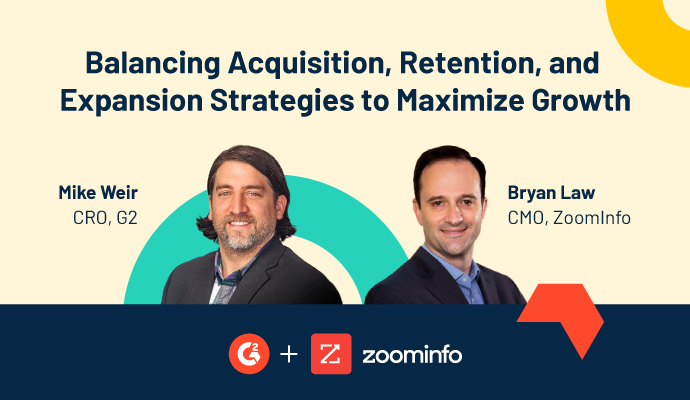June 5, 2023
 by Stephen Hoops / June 5, 2023
by Stephen Hoops / June 5, 2023

When budgets get tighter, marketing and sales teams are left with the task of doing more with less.
During times of economic downturn, achieving greater efficiency becomes a gigantic priority. Many companies are reducing spending, raising questions about where to put time and resources.
The good news is that despite the inherent challenges of less budget, these teams can work together to become more resourceful and find creative solutions. It all comes down to finding common ground to pursue strategic targets and investing their efforts to yield positive returns.
In a recent webinar cohosted by G2 + ZoomInfo, attendees heard Bryan Law, Chief Marketing Officer at ZoomInfo, and Mike Weir, Chief Revenue Officer at G2, talk about how companies can find the right balance between customer acquisition, retention, and expansion to maximize revenue growth.
If you missed the webinar, this article covers some of the highlights of their conversation and some actionable strategies to boost retention and expansion.
A big question on the mind of companies and their revenue organizations involves where to prioritize their efforts to either acquire new customers or retain and expand relationships with existing ones. Unfortunately, it’s a complex and nuanced question with no one-size-fits-all answer.
Balancing these three areas in revenue management largely depends on a company’s maturity level. Conventional wisdom indicates that high-growth startups are primarily concerned with acquisition, whereas later-stage companies focus on their existing customer base. But as some industry experts suggest, companies may miss huge opportunities if they emphasize one of these areas too much.
It’s also worth considering that Ehrenberg-Bass, one of the most reputable marketing research organizations, published a study that suggests new user acquisition is a more reliable growth strategy for B2B companies than customer loyalty.
In a time when everyone is spending less, it’s critical to ask whether it makes sense to invest more heavily in acquisition than retention or expansion. These areas require different resources and costs, and might not drive the necessary revenue growth. In the webinar, Mike Weir of G2 gave his perspective on the differences between each.
All companies have unique circumstances and inputs that can impact the decision to invest their efforts. Mike Weir thinks that one way to determine which areas to explore involves understanding your position in the marketplace.
Mike Weir
Chief Revenue Officer, G2
While customer acquisition will always remain a priority for revenue organizations, Mike went on to talk about what the Ehrenberg-Bass study doesn’t reflect. As brands grow their reputation and awareness in the market, buyers are naturally more open to learning about your solutions and ultimately buying from you.
At one point in the webinar, Bryan Law of ZoomInfo shared his perspectives on what considerations can help companies determine areas of revenue growth to prioritize. The following are key questions to ask to help get those conversations going.
Your situation might deem acquiring customers a necessity. However, due to recent economic uncertainty, in addition to an already complex buying process, many companies are exploring how they can reduce churn and build upon good customer relationships more than ever.
Pursuing new customers can only go so far with limited resources, and it’s essential to understand how to grow customer revenue. The following are several strategies straight from revenue and marketing experts to help improve retention and expansion efforts.
Preaching the importance of sales and marketing alignment isn’t groundbreaking. Many industry experts and thought leaders often tout the benefits of alignment as an essential framework for companies to achieve business goals and remain competitive.
Everyone talks a good game about alignment, but the reality is that few B2B organizations feel there’s a strong alignment between these teams. At one point in the webinar, Bryan stated that many revenue inefficiencies lie in that disconnect between sales and marketing.
When you break it down, alignment is about mutual understanding. Marketers need to understand the goals sales are aiming for, and sales need to understand what marketing can realistically achieve with its allotted resources.
In terms of what drives the decision to invest in acquisition, retention, or expansion, Mike talked about two concepts that are extremely important to track to set the right expectations and drive desired outcomes.
As mentioned earlier, greater brand awareness and recognition in the market make buyers more open to researching your offerings. But getting to that point where you become a leader takes time and consistency.
To help mitigate the challenge of achieving greater brand awareness, the voice of the customer can be massively impactful in creating stronger messaging and establishing a foundation for positive market sentiment. What’s even better is that utilizing the voice of the customer can positively affect acquisition and expansion efforts.
“If you're thinking about customer success in a really good way, then you take that solid base of happy customers and empower them to speak on your behalf,” says Mike. “I think one of the most important things to bear in mind is that buyers talk among themselves and educate each other on who is the right company or solution to consider.”
Despite its utility and strength as a tool for having a meaningful impact throughout the funnel, many organizations struggle with operationalizing intent data to its fullest. We know that G2 Buyer Intent data can drive significant outcomes and target buyers at precise moments, but many might not realize that this data can go far beyond acquisition.
Another key aspect of sales and marketing empowering one another is creating multithreaded relationships with buyers and customers to understand what’s turning customers away and how you can build upon good relationships.
To aid in this, Mike and Bryan discussed how certain intent signals could help identify these opportunities.
When it comes to engaging customers, getting it right is a delicate balancing act. For example, it’s becoming increasingly common that delivering a business outcome requires engaging more than one customer contact.
Mike Weir
Chief Revenue Officer, G2
Ultimately, your goal is to solve the problem your customers and buyers have. Regardless of whether you have a solid relationship, they need you to deliver value.
“Sometimes, it's challenging to make our customers successful when we don't know what success actually means for them,” said Bryan. “Being in those conversations to understand the key priorities for those businesses is necessary to deliver the value you want.”
Since minimizing risk is a component of retaining customers and finding expansion opportunities, mastering engagement with the right rhythm is crucial.
Balancing priorities across customer acquisition, retention, and expansion can be a tough nut to crack. Finding the right mix between these areas requires understanding your position in the marketplace, how you’re delivering value to customers, and exploring which investments will yield the best opportunities with limited resources.
To see the webinar in full, check out the on-demand recording of Balancing Customer Acquisition, Retention, and Expansion Strategies to Maximize Revenue Growth.
Stephen Hoops is a former Sr. Content Marketing Specialist at G2. He focused on creating content that helps tech industry sales professionals and B2B SaaS marketers find success with G2 products such as Buyer Intent, Review Generation, and more. After receiving his B.A. in Journalism from West Virginia University in 2013, he has helped countless B2B brands reach new highs through content creation and SEO. When not nerding out about the artistry behind well-written copy, Stephen can be found info-dumping about homemade cocktails, Italian cuisine, and why vinyl is the superior physical medium for music.
As a business powered by customer voice, we embrace any opportunity to capture feedback from...
 by Godard Abel
by Godard Abel
In a recent meeting with G2's Executive Advisory Board (EAB), our leadership team discussed...
 by Godard Abel
by Godard Abel
In a sea of stakeholders, pick the customer.
.jpg) by Aayushi Sanghavi
by Aayushi Sanghavi
As a business powered by customer voice, we embrace any opportunity to capture feedback from...
 by Godard Abel
by Godard Abel
In a recent meeting with G2's Executive Advisory Board (EAB), our leadership team discussed...
 by Godard Abel
by Godard Abel


